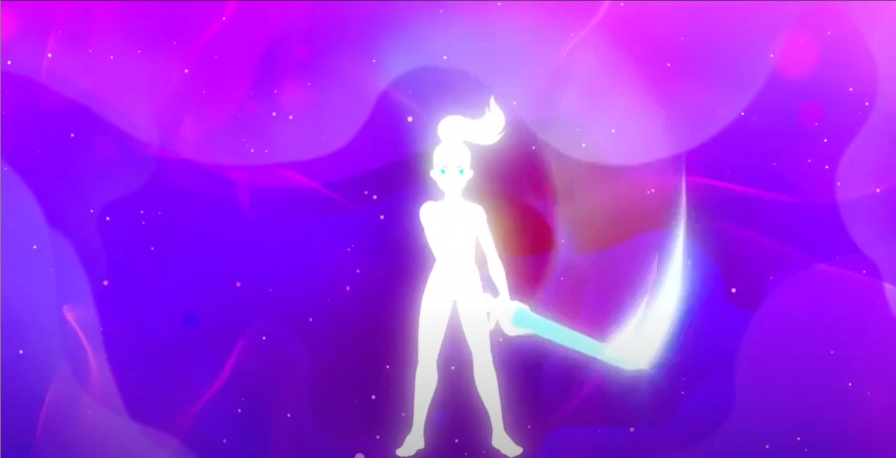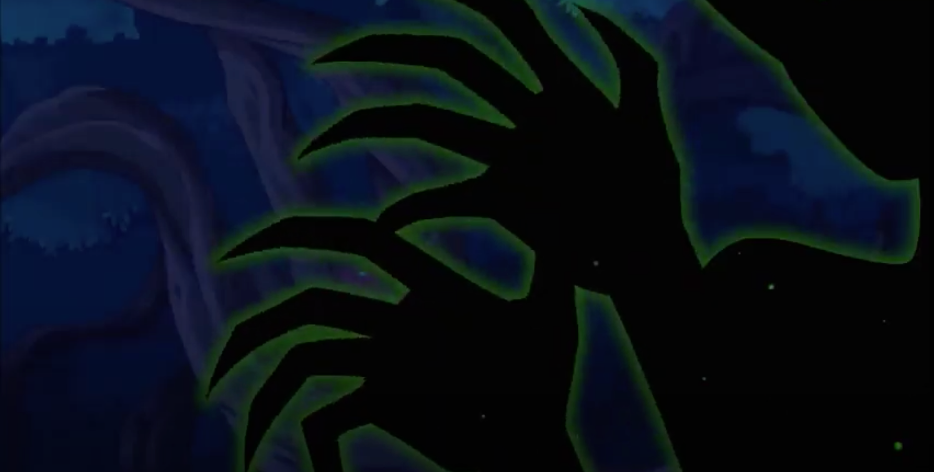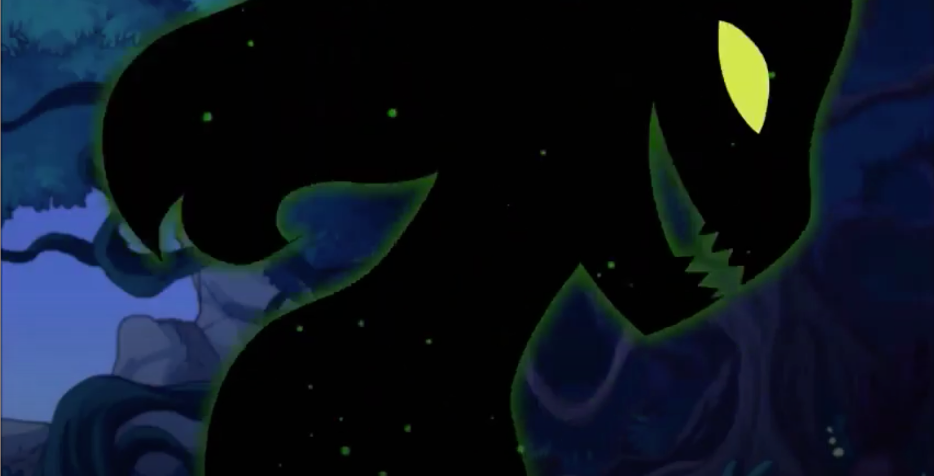Reminiscent of magical girl anime, Adora’s transformation into She-Ra (in She-Ra and the Princesses of Power, 2018-2020) serves an empowering function by way of a stylistic and physiological change. Her transformation sequence borrows from two types of transformation made popular in animation by magical girls. The first is a literal physical transformation in the likes of pre-1990s magical girl anime as seen in The Secrets of Akko-Chan (1969-1970), and Creamy Mami, the Magical Angel (1983-1984), where young girls have the ability to transform into adolescents or adults. The second transformation trope adopted by She-Ra comes in the form of a makeover as—while Adora grows taller and more muscular—she keeps her main features but experiences a change in costume, an extravagant growth of hair, and slightly brighter eyes. Part of this formation, of course, recalls the original She-Ra series from the 1980s, while the way it is animated is informed by the magical girl anime series from the 1990s and beyond.
In some cases in scholarly writings, the magical girl transformation sequence has been framed as a feminine empowering device (see Napier 2001; Sugawa-Shimada 2011), but also as a tool to encourage the purchase of toys based on narrative gadgets spotlighted during these repeated sequences (see Allison 2006; Hartzheim 2016). Both these paradigms suggest that a particular form of relationship is created between viewers and magical girls. The former does so through an identification process with the characters, and the latter by way of mimicking choreographed transformation through play using toys. I contend that Adora’s transformation sequence, while not necessarily motivating the purchase of toys (though they do exist), has a similar effect of suturing the viewers to the character. This prompts questions about the role of Double Trouble’s shape-shifting transformation, which suggests a reversal or a renegotiation of the suturing effect produced by Adora’s sequence. As we will see, the act of transformation in Double Trouble’s case unveils the constructive nature of gender, allowing for its potential multiplicity to appear on the surface of the character’s body. But first, let us attend to Adora’s sequence to better understand how Double Trouble’s transformation is quite distinct from the heroine’s in style and function.

Adora’s transformation sequence is triggered as she lifts her sword skyward loudly uttering the incantation “For the Honour of Grayskull!” while the image tracks toward the sword’s gem, as a rainbow emits around it. Colour beams then spread across the image, transporting Adora from the world of Etheria to the transformation space. Akin to Usagi’s transformation into Sailor Moon (Sailor Moon 1992-1997), Adora’s body is almost entirely hollowed and filled with a flat bright white, except for her eyes and eyebrows, as she floats in a colorful magical space that seemingly appears to have no specific location (Figure 1). Her silhouette is tripled by lines of different shades which are filled as the inner space of the character expands outward, before elements of her costume appear in sequence, covering the surface of her body from toes to head, as flames awaken the dormant warrior She-Ra.
This iconic look allows Adora to become a blank sheet to be drawn upon, and acts as an identification device through what comic book theorist Scott McCloud (1993, 43) calls “lines to be”. In his book Understanding Comics, McCloud draws an iconic abstraction scale with two extreme poles: realistic and iconic (see McCloud 1993, 46), or what he calls “lines to see” and “lines to be” (ibid., 43). He contends that the former notion conveys photographic-like art which is framed as closer to reality, while the latter extreme illustrates an abstract face (one circle for the head, two dots for the eyes, and one straight line for the mouth), linking it to iconic imagery (ibid., 46). McCloud argues that to look at a realistic drawing of a face produces a particular form of distance between the viewer and the object, as the viewer sees the illustrated subjects as someone else’s face (ibid., 36). He frames the cartoon styled character as “a vacuum into which our identity and awareness are pulled, an empty shell that we inhabit, which enables us to travel to another realm,” arguing that “we don’t just observe the cartoon—we become it” (ibid., 36). Following McCloud’s logic of lines to be, the character’s design is further abstracted during She-Ra’s transformation sequence, tending towards an even more iconic look, thus positioning the sequence as the peak of drawing viewers into the cartoon world. She-Ra’s white and golden outfit combined with a rainbow and light themed transformation—supported by an uplifting soundtrack in the major scale—positions her as a valiant hero, one to root for and identify with. Whether it is through character design or the relationship between the viewers as potential toy consumers, the magical girl’s transformation sequence has been framed as an entry point into the animated world, making it a standard tool connecting viewers with characters through its repetition over various iterations in the magical girl genre, and shows inspired by it.
While Adora’s transformation stands as the series’ ‘money shot’[1] recycled from episode to episode, she is not the only character who experiences a form of transformation. Indeed, the series explores transformation another way through the non-binary villain Double Trouble, voiced by non-binary LGBTQA+ activist and actor Jacob Tobia. McCloud’s notion of lines to be takes a literal turn in the context of Double Trouble as they often morph into the likes of the character they are facing, becoming them, which is usually met with stupefaction, or even horror. Compared to Adora’s transformation, which pulls viewers in, Double Trouble’s stubbornly pushes them out, provoking unnerving reactions both from the viewers and the characters. Their transformation differs not only by its tonal contrast with Adora’s (and magical girls’), but by taking the form of striking divergent shapes when they shift from the adorable pink and innocent-looking Flutterina to their most standard dark clothed lizard form, to name one example.
Double Trouble cannot be said to have a transformation sequence in the same way the magical girl does, as they abruptly transform without warning (not requiring any spell casting) while remaining anchored in the same setting from one state to the other. Their transformation zone lies within themselves, slightly spreading out of their hollowed figure as green orbs of light float around their changing shape. Since Double Trouble’s act of morphing slightly changes from one instance to another, I now turn to one specific moment where they transform in the fourth episode of season four. Meeting with Catra after spreading chaos amongst the Princesses at Castle Bright Moon, Double Trouble as Flutterina breaks out of character as their body slowly empties itself from any lines and colours. Contrary to Adora’s bottom to top transformation, the fairy’s contours are made a glowing green as pitch black is laid upon the character’s whole surface, erasing their design from head to toe. This is followed by a close-up of their feet elongating and becoming narrower, while a long curly tail appears wiggling behind.

The delicate hands of the pink fairy morph into long monstrous claws (Figure 2), followed by a close-up shot of the side of their head, as their eyes turn yellow and teeth sharpen, revealing a mischievous smile (Figure 3). Double Trouble’s transformation is finalized as their Nosferatu-like silhouette is filled from top to bottom revealing what seems to be their default state. Punctuated by minor scale eerie music, the soundtrack offers flowing liquid-like sound effects, and what resembles leaves rustling. The sound work suggests that the character’s body liquefies akin to a caterpillar morphing in the cocoon, while being mixed with what appears to be the sound of a snake shedding its skin. Needless to say, Double Trouble’s transformation is on the uncanny side, a zone troubling the pulling effect of lines to be, drawing you in, while casting you out simultaneously.

Double Trouble’s constant change from one state to another rings true with Judith Butler’s deconstruction of gender (inspired by Esther Newton’s work) where she argues that “the structure of impersonation reveals one of the key fabricating mechanisms through which the social construction of gender takes place” (Butler 1990, 186). While Adora has two main modes of being and through her journey navigates from one allegiance (The Horde) to another (The Princesses of Etheria), Double Trouble has countless modes, and sides with whom they deem the most profitable, demonstrating a wavering loyalty. In this light, the non-binary antagonist can be positioned as a sort of “in-betweener” as they attest that their original form is “more or less” accurate since, in their own words, “we all wear costumes,” a clear nod to the concept of performativity. Compared to other villains such as Catra, Shadow Weaver or even Hordak, Double Trouble is never given any origin story, nor a redemption arc, making for a character without a genesis, yet in a constant state of becoming. Using a similar transformative device in the emptying of the character, while corrupting it by expelling the viewer from its inner shell, the mercenary refuses to embody any form of permanently fixed appearance. By way of constant transformations, Double Trouble represents gender as social construct by deconstructing and rebuilding upon it, making “the original identity after which gender fashions itself . . . an imitation without an origin” (Butler 1990, 188). Their inner space becomes a force of attraction which one can never fully inhabit—or perhaps can only inhabit temporarily—as it swiftly shifts with unannounced violence.
References
Allison, Anne (2006), Millennial Monsters: Japanese Toys and the Global Imagination, Berkeley: University of California Press.
Butler, Judith (1990), Gender Trouble: Feminism and the Subversion of Identity, New York: Routledge.
Hartzheim, Bryan Hikari (2016), “Pretty Cure and the Magical Girl Media Mix.” The Journal of Popular Culture, 48 (5), pp. 1059-1085.
McCloud, Scott (1993). Understanding Comics: The Invisible Art, New York: Kitchen Sink Press.
Napier, Susan J. (2001), Anime from Akira to Princess Mononoke: Experiencing Contemporary Japanese Animation, London: Palgrave Macmillan.
Sugawa-Shimada, Akiko (2011), Representations of Girls in Japanese Magical Girl TV Animation Programmes from 1966 to 2003 and Japanese Female Audiences’ Understanding of Them. University of Warwick, Ph.D. dissertation.
Alexandre G. Vermeil is currently completing a Master of Arts in Film Studies at Concordia University, Montreal. He received a BFA in the Specialization in Film Studies program at the same institution. His research interest includes animation/anime studies, comic book/manga studies, and queer theory. His Master’s thesis consists of a character study of the magical boy figure in various Japanese media, through the lens of queer theory. He is currently Co-President of Concordia’s Film Studies Graduate Association, member of the Platform Lab, the Animating Television reading/research group, and part of the Synoptique: An Online Journal of Film and Moving Image Studies editorial collective.
[1] In her book Millenial Monsters, Anne Allison equates transformation sequences in the Power Rangers series (and Sailor Moon) with the concept (Alison 2006, 103). The term originates from Linda Williams’ Hard Core (1989) where she frames the man’s ejaculation in porn to an anticipated and heightened moment that is central to the whole scene as a moment of spectacle.

CUT the CORD with FREE! FREE! FREE! Live TV and premium channels.
Get live tv channels including local news, HD channels along with premium channels for $0, signup at http://www.TeatherNW.com NO strings attached. Why pay for Cable T.V. or Dish when you can enjoy the same channels for free. Teather Network continues to add more channels for your viewing pleasure. Come join the Teather family and see the difference, you’ll be happy you did.
I absolutely love this spot on analysis. One thing I’ll add to the conversation is how I appreciated Adora’s newer transformation in season five and the renewed sense of embodiment to it. All of a sudden, her movements are more fluid and brimming with vulnerability and personality, less static than when she was just playing the role of She-Ra. It’s a brilliant way to show her character development through animated movement.
Hello All, I believe TeatherNW.com is a great fit for all Animators, Cartoonists, Storyboard Artists, VFX. Check it out, you’ll be HAPPY you did. TeatherNW.com will Get your content, concept and hard work NOTICED!